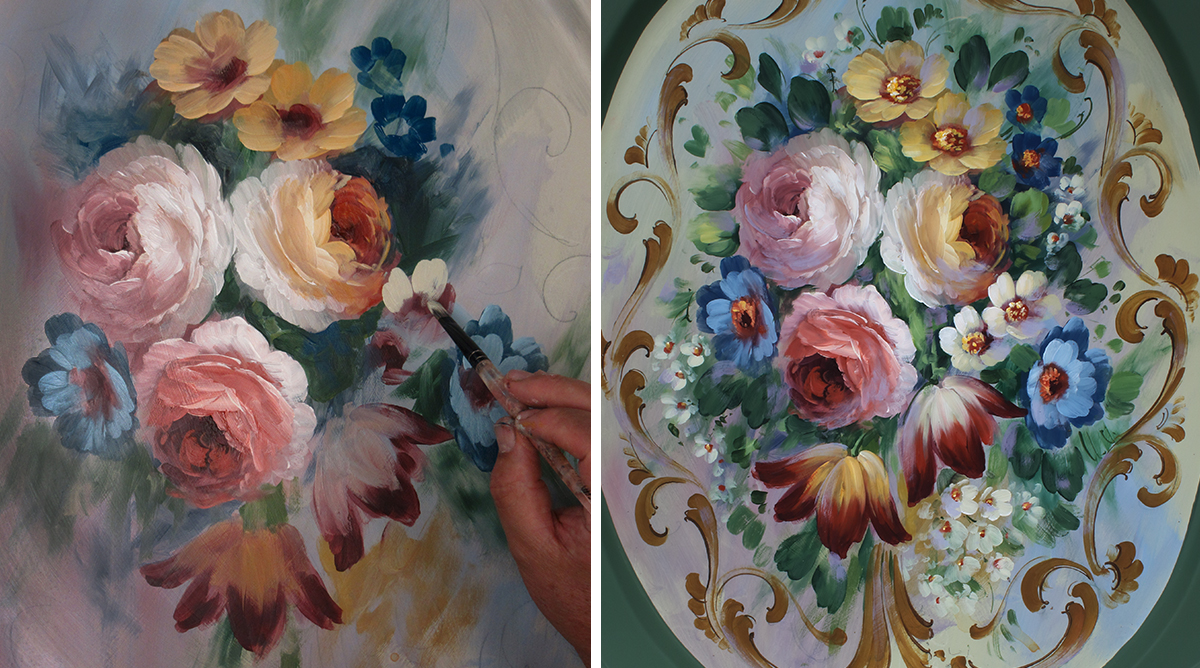
OK… This is a long one, I really hope all my artist friends grab a cuppa of strong coffee and take the time to read these morning thoughts 🙂 Back in 1983 I painted my first Valdres Rosemaling piece. I had been Rosemaling with many great teachers since 1975. Valdres though, I didn’t want to paint because it had flowers. Now, of course it is one of my favorite styles. Why? Flowers. LOL.
This month we are releasing 3 new volumes to our Rosemaling inspiration series of books showing some inspired designs and new ways of doing things. I write all the time about “change” and how it not only fuels creativity, but also attracts new people to the market. I remember for years and years going to conventions and all the exhibitors would put up signs “NEW”…”NEW” then the customers would come to the show floor and ask “What is NEW”.
One very difficult subject to talk to Rosemalers about is old vs. new. I understand that. One would think that Rosemaling is “traditional”, but when you look closely at its history, you see each style “changed” from artist to artist and through each design period. Why was Rosemaling so popular in the 1980’s and 1990’s then faded away? It was new to many people. Why did decorative painting grow so fast and then fade away? It was new. Why did people slowly lose interest in most forms of decorative painting and Rosemaling? I always come back to the same answer my teachers warned me about. Change.
Early Rosemalers were always updating their styles to what was popular at the time. Today, we can look back and clearly see the evolution of the designs. For example, Ole Halstensen Sjoli updated the Osterdalen style through the Rococo, Louis XVI and Empire periods. He created many variations of Osterdalen. After his death in 1827, the style all but disappeared. Fresh ideas and creativity are necessary to keep painting styles alive. When the creators of a style passes, the style loses momentum unless there are powerful students and successors to carry on.
Designs and styles move from one extreme to the other. For example, the fluid, fanciful style of the Rococo and Louis XVI era was followed by the strict lines of the Empire and Regency. Styles reversed again during the Impressionist movement of the later 19th century. So what was popular in one era, the opposite style is bound to become popular again in another design period. Change!
When I started to paint in the 1970s, the styles were painted freehand, without a pattern. By the time bottle acrylics arrived in the middle 1980s, the styles had become more precise, mechanical and symmetrical. Perfect side loads and detailed line work were considered the mark of a professional, especially in the American Rogaland style. The styles had changed from freehand, to patterns and mechanics. I studied and perfected my mechanics, concentrating on stroke blending and perfect lines. Then the trend changed in the early 2000s and the decorative painting market started to collapse. It started to collapse because we didn’t change with the trend. The trend was returning back to “freehand” art. People change and art needs to change too. Why does “plein air” become more popular? THOUSANDS go to those conventions each year and the decorative painting industry has collapsed. Why, Fun…. Grab some paint, a couple brushes and go paint something. You don’t need to take the time to basecoat and put on a pattern.
With this in mind, I began to relax the lines in Rosemaling. I created “casual” styles of painting. I switched from stiff synthetic brushes to the softer fusion brushes. These synthetic squirrel hair brushes do not allow precise strokes. Squirrel and cow hair brushes are the earliest brushes used in Rosemaling. I returned to painting freehand and limited my palette colors. Start designs with “sketches” and not patterns. The majority of my students embraced this new method. The old structured way was no longer fun. I was returning to the free hand method of creating and allowing each artist to express their individual style. It takes practice and courage to paint freehand, but it is the key to making the style grow and change. Today, for me, the structure of the 90s has given way to more casual interpretations.
I now look at the styles of Rosemaling and see where I can advance the looks, add more artistic principles and make a change. For this Valdres piece I added some additional concepts of “fine art” such as negative painting, harmony coloring, workup tones etc. It changed the approach to painting this style and I really love it. I worked the entire painting, all flowers at the same time and not one flower at a time. Not, basecoat, shadow and highlight. Some of you will embrace the change and some will not. It is ok! The change is to keep it interesting. Keep it fun!!!!
To ALL my artistic friends who LOVE Folk Art as I do…. Let’s all take a really good look at the history of our art. Be honest, where are the next generation of painters today? Why haven’t they embraced these time tested art forms, and made the necessary changes to attract the next generation of artist? History gives us the answers if we truly look.
Today, in art universities, there is a push on “individualism”. The students are pushed to “create their own work”. Guess what…. they don’t use patterns. Decorative painters still do. When I started Rosemaling and sat in my first Telemark class in 1975, there was not a pattern. Just an idea, a style, a concept and a starting point. Let the paint flow and find the shapes. Rosemaling is PERFECT for artists today who are graduating from universities if we just return to a few principles that historical Rosemalers used when they created new styles of Rosemaling. WE GOT THIS!

Thanks for the insight, David.